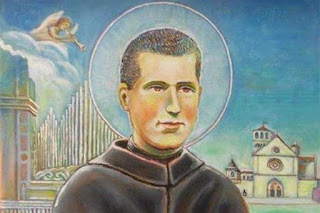How many more friends of St. Maxmilian Kolbe do we have?
SERVANT of GOD ANTONIO MARIA MANSI was born in
He was sent to Bagnoregio (Viterbo) for high school studies, and to
For theology he was sent to
On March 19, 1918, Fra Antonio Mansi made his solemn profession in the hands of His Eminence Cardinal Boschi and was ordained a priest on May 9, 1918 in the chapel of the college.
As a man of culture, Fra Mansi spoke English, French, Latin well and knew Greek. He successfully cultivated poetry, song and music, in which he perfected himself at the Pontifical Institute of Sacred Music in
He fell ill with the Spanish flu, which he contracted while nursing a Father. He died on October 31, 1918, offering his life for the good of the Church, for Pope Benedict XV and for the Order and invoking the name of Mary.
Father Kolbe wrote in his Diary: "On October 31, 1918, in the morning, Fra Antonio Mansi fell asleep in the Lord with a very edifying death. Before dying he promised me to "make me walk straight with good or bad." He cultivated in a sublime way humility, obedience, patience, simplicity, religious poverty, brotherly love, commitment to the most exact observance of the rules, the most lively faith, the most tender attachment to prayer, to the glory of God, to the Church, to the Holy Father and to the Order, a firm, unshakable hope ".
VENERABLE MELCHIOR FORDONwas born in 1862 in
Fra Melchior began his ministerial life as a diocesan priest for the Diocese of Vilnius. He served as parish priest of various locations and as guardian over a house for constricted priests deemed dangerous to the Russian state. He was very active during the socialist revolution in Russia , collecting signatures among the clergy and the faithful asking for the intervention of Pope St. Pius X in the case of the archbishop of Vilnius, interned in 1907 by the Tsarist police.
His activities exposed him to the Tsarist authorities and they soon decided to ban him from pursuing pastoral activities in the Russian empire. He was moved from the district to more remote areas.
He was stationed at
The officer spared their lives, stating that if it turned out to be true that they were Russian spies, then he would be shot. The next day, a fire broke out in the city, which the Germans called on previously arrested firemen to extinguish it. After suppressing the fire, the German commander withdrew the earlier order for their execution and ordered them to be released from custody.[
After 23 years of priesthood, and with the consent of the diocese, Fr. Melchior discerned to enter the Conventual Franciscans in Kracow.
He was a collaborator of St. Maxmilian, who in 1922 transferred the publishing of the magazine from Kraków to


